Publications
2025
-
 Fisher Information Flow in Artificial Neural NetworksMaximilian Weimar, Lukas M. Rachbauer, Ilya Starshynov, Daniele Faccio, Linara Adilova, Dorian Bouchet, and Stefan RotterPhysical Review X 15, 031072 (Sep 2025)
Fisher Information Flow in Artificial Neural NetworksMaximilian Weimar, Lukas M. Rachbauer, Ilya Starshynov, Daniele Faccio, Linara Adilova, Dorian Bouchet, and Stefan RotterPhysical Review X 15, 031072 (Sep 2025)The estimation of continuous parameters from measured data plays a central role in many fields of physics. A key tool in understanding and improving such estimation processes is the concept of Fisher information, which quantifies how information about unknown parameters propagates through a physical system and determines the ultimate limits of precision. With artificial neural networks gradually becoming an integral part of many measurement systems, it is essential to understand how they process and transmit parameter-relevant information internally. Here, we present a method to monitor the flow of Fisher information through an artificial neural network performing a parameter estimation task, tracking it from the input to the output layer. We show that optimal estimation performance corresponds to the maximal transmission of Fisher information and that training beyond this point results in information loss due to overfitting. This provides a model-free stopping criterion for network training—eliminating the need for a separate validation dataset. To demonstrate the practical relevance of our approach, we apply it to a network trained on data from an imaging experiment, highlighting its effectiveness in a realistic physical setting.
-
 Model-free estimation of the Cramér–Rao bound for deep learning microscopy in complex mediaIlya Starshynov, Maximilian Weimar, Lukas M. Rachbauer, Günther Hackl, Daniele Faccio, Stefan Rotter, and Dorian BouchetNature Photonics 19, 593–600 (Jun 2025)
Model-free estimation of the Cramér–Rao bound for deep learning microscopy in complex mediaIlya Starshynov, Maximilian Weimar, Lukas M. Rachbauer, Günther Hackl, Daniele Faccio, Stefan Rotter, and Dorian BouchetNature Photonics 19, 593–600 (Jun 2025)Artificial neural networks have become important tools to harness the complexity of disordered or random photonic systems. Recent applications include the recovery of information from light that has been scrambled during propagation through a complex scattering medium, especially in the challenging case in which the deterministic input–output transmission matrix cannot be measured. This naturally raises the question of what the limit is that information theory imposes on this recovery process, and whether neural networks can actually reach this limit. To answer these questions, we introduce a model-free approach to calculate the Cramér–Rao bound, which sets the ultimate precision limit at which artificial neural networks can operate. As an example, we apply this approach in a proof-of-principle experiment using laser light propagating through a disordered medium, evidencing that a convolutional network approaches the ultimate precision limit in the challenging task of localizing a reflective target hidden behind a dynamically fluctuating scattering medium. The model-free method introduced here is generally applicable to benchmark the performance of any deep learning microscope, to drive algorithmic developments and to push the precision of metrology and imaging techniques to their ultimate limit.
2024
-
 Near-field acoustic imaging with a caged bubbleDorian Bouchet, Olivier Stephan, Benjamin Dollet, Philippe Marmottant, and Emmanuel BossyNature Communications 15, 10275 (Nov 2024)
Near-field acoustic imaging with a caged bubbleDorian Bouchet, Olivier Stephan, Benjamin Dollet, Philippe Marmottant, and Emmanuel BossyNature Communications 15, 10275 (Nov 2024)Bubbles are ubiquitous in many research applications ranging from ultrasound imaging and drug delivery to the understanding of volcanic eruptions and water circulation in vascular plants. From an acoustic perspective, bubbles are resonant scatterers with remarkable properties, including a large scattering cross-section and strongly sub-wavelength dimensions. While it is known that the resonance properties of bubbles depend on their local environment, it remains challenging to probe this interaction at the single-bubble level due to the difficulty of manipulating a single resonating bubble in a liquid. Here, we confine a cubic bubble inside a cage using 3D printing technology, and we use this bubble as a local probe to perform scanning near-field acoustic microscopy—an acoustic analog of scanning near-field optical microscopy. By probing the acoustic interaction between a single resonating bubble and its local environment, we demonstrate near-field imaging of complex structures with a resolution that is two orders of magnitudes smaller than the wavelength of the acoustic field. As a potential application, our approach paves the way for the development of low-cost acoustic microscopes based on caged bubbles.
-
 How to find optimal quantum states for optical micromanipulation and metrology in complex scattering problems: tutorialLukas M. Rachbauer, Dorian Bouchet, Ulf Leonhardt, and Stefan RotterJournal of the Optical Society of America B 41, 2122–2139 (Sep 2024)
How to find optimal quantum states for optical micromanipulation and metrology in complex scattering problems: tutorialLukas M. Rachbauer, Dorian Bouchet, Ulf Leonhardt, and Stefan RotterJournal of the Optical Society of America B 41, 2122–2139 (Sep 2024)The interaction of quantum light with matter is of great importance to a wide range of scientific disciplines, ranging from optomechanics to high-precision measurements. A central issue we discuss here, is how to make optimal use of both the spatial and the quantum degrees of freedom of light for characterizing and manipulating arbitrary observable parameters in a linear scattering system into which suitably engineered light fields are injected. Here, we discuss a comprehensive framework based on a quantum operator that can be assembled solely from the scattering matrix of a system and its dependence on the corresponding local parameter, making this operator experimentally measurable from the far field using only classical light. From this, the effect of quantum light in the near field, i.e., in the vicinity of the target object, can be inferred. Based on this framework, it is straightforward to formulate optimal protocols on how to jointly design both the spatial shape and the quantum characteristics of light for micromanipulation as well as for parameter estimation in arbitrarily complex media. Also, the forces of the quantum vacuum naturally emerge from this formalism. The aim of our tutorial is to bring different perspectives into alignment and thereby build a bridge between the different communities of wave control, quantum optics, micromanipulation, quantum metrology, and vacuum physics.
-
 Continuity equation for the flow of Fisher information in wave scatteringJakob Hüpfl, Felix Russo, Lukas M. Rachbauer, Dorian Bouchet, Junjie Lu, Ulrich Kuhl, and Stefan RotterNature Physics 20, 1294–1299 (Aug 2024)
Continuity equation for the flow of Fisher information in wave scatteringJakob Hüpfl, Felix Russo, Lukas M. Rachbauer, Dorian Bouchet, Junjie Lu, Ulrich Kuhl, and Stefan RotterNature Physics 20, 1294–1299 (Aug 2024)Using waves to explore our environment is a widely used paradigm, ranging from seismology to radar technology, and from biomedical imaging to precision measurements. In all these fields, the central aim is to gather as much information as possible about an object of interest by sending a probing wave at it and processing the information delivered back to a detector. Here we demonstrate that an electromagnetic wave scattered at an object carries locally defined and conserved information about all of the object’s constitutive parameters. Specifically, we introduce the density and flux of Fisher information for general types of wave fields and identify the corresponding sources and sinks of information through which all these new quantities satisfy a fundamental continuity equation. We experimentally verify our theoretical predictions by studying a movable object embedded in a disordered environment and by measuring the corresponding Fisher information flux at microwave frequencies. Our results improve the understanding of the generation and propagation of information and open up possibilities for tracking and designing the flow of information even in complex environments.
-
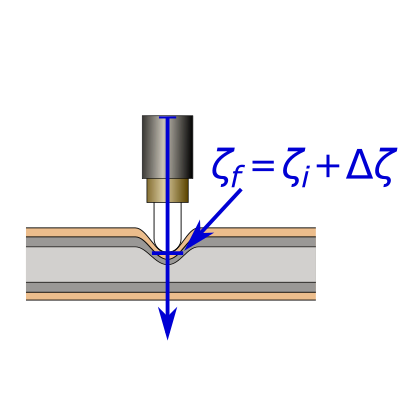 Reaching the precision limit with tensor-based wavefront shapingRodrigo Gutiérrez-Cuevas, Dorian Bouchet, Julien Rosny, and Sébastien M. PopoffNature Communications 15, 6319 (Jul 2024)
Reaching the precision limit with tensor-based wavefront shapingRodrigo Gutiérrez-Cuevas, Dorian Bouchet, Julien Rosny, and Sébastien M. PopoffNature Communications 15, 6319 (Jul 2024)Perturbations in complex media, due to their own dynamical evolution or to external effects, are often seen as detrimental. Therefore, a common strategy, especially for telecommunication and imaging applications, is to limit the sensitivity to those perturbations in order to avoid them. Here, instead, we consider enhancing the interaction between light and perturbations to produce the largest change in the output intensity distribution. Our work hinges on the use of tensor-based techniques, presently at the forefront of machine learning explorations, to study intensity-based measurements where its quadratic relationship to the field prevents the use of standard matrix methods. With this tensor-based framework, we can identify the maximum-information intensity channel which maximizes the change in its output intensity distribution and the Fisher information encoded in it about a given perturbation. We further demonstrate experimentally its superiority for robust and precise sensing applications. Additionally, we derive the appropriate strategy to reach the precision limit for intensity-based measurements, leading to an increase in Fisher information by more than four orders of magnitude compared to the mean for random wavefronts when measured with the pixels of a camera.
2023
-
 Maximum-likelihood estimation in ptychography in the presence of Poisson–Gaussian noise statisticsJacob Seifert, Yifeng Shao, Rens van Dam, Dorian Bouchet, Tristan van Leeuwen, and Allard P. MoskOptics Letters 48, 6027–6030 (Nov 2023)
Maximum-likelihood estimation in ptychography in the presence of Poisson–Gaussian noise statisticsJacob Seifert, Yifeng Shao, Rens van Dam, Dorian Bouchet, Tristan van Leeuwen, and Allard P. MoskOptics Letters 48, 6027–6030 (Nov 2023)Optical measurements often exhibit mixed Poisson–Gaussian noise statistics, which hampers the image quality, particularly under low signal-to-noise ratio (SNR) conditions. Computational imaging falls short in such situations when solely Poissonian noise statistics are assumed. In response to this challenge, we define a loss function that explicitly incorporates this mixed noise nature. By using a maximum-likelihood estimation, we devise a practical method to account for a camera readout noise in gradient-based ptychography optimization. Our results, based on both experimental and numerical data, demonstrate that this approach outperforms the conventional one, enabling enhanced image reconstruction quality under challenging noise conditions through a straightforward methodological adjustment.
-
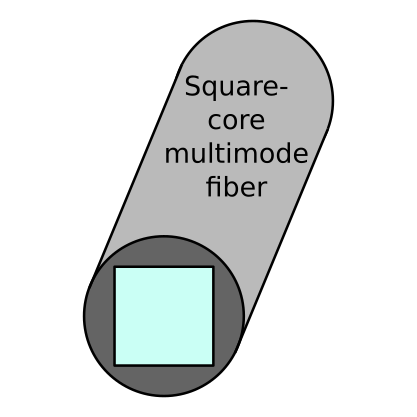 Speckle-correlation imaging through a kaleidoscopic multimode fiberDorian Bouchet, Antonio Miguel Caravaca-Aguirre, Guillaume Godefroy, Philippe Moreau, Irène Wang, and Emmanuel BossyProceedings of the National Academy of Sciences 120, e2221407120 (Jun 2023)
Speckle-correlation imaging through a kaleidoscopic multimode fiberDorian Bouchet, Antonio Miguel Caravaca-Aguirre, Guillaume Godefroy, Philippe Moreau, Irène Wang, and Emmanuel BossyProceedings of the National Academy of Sciences 120, e2221407120 (Jun 2023)Speckle-correlation imaging techniques are widely used for noninvasive imaging through complex scattering media. While light propagation through multimode fibers and scattering media share many analogies, reconstructing images through multimode fibers from speckle correlations remains an unsolved challenge. Here, we exploit a kaleidoscopic memory effect emerging in square-core multimode fibers and demonstrate fluorescence imaging with no prior knowledge on the fiber. Experimentally, our approach simply requires to translate random speckle patterns at the input of a square-core fiber and to measure the resulting fluorescence intensity with a bucket detector. The image of the fluorescent object is then reconstructed from the autocorrelation of the measured signal by solving an inverse problem. This strategy does not require the knowledge of the fragile deterministic relation between input and output fields, which makes it promising for the development of flexible minimally invasive endoscopes.
-
 Temporal shaping of wave fields for optimally precise measurements in scattering environmentsDorian Bouchet, and Emmanuel BossyPhysical Review Research 5, 013144 (Feb 2023)
Temporal shaping of wave fields for optimally precise measurements in scattering environmentsDorian Bouchet, and Emmanuel BossyPhysical Review Research 5, 013144 (Feb 2023)A wave propagating through a scattering medium typically yields a complex temporal field distribution. Over the years, a number of procedures have emerged to shape the temporal profile of the field in order to temporally focus its energy on a receiver. By analogy, we theoretically and experimentally demonstrate here how to maximize the total Fisher information transmitted to a receiver, and how to focus the Fisher information at any given time. This enables one to estimate small variations in the value of any physical observable with optimal precision from noisy measurements, as experimentally illustrated using acoustic waves in the ultrasound regime. By yielding the ultimate precision limit achievable from time-resolved measurements performed in arbitrarily complex media, our approach sets a general benchmark for many applications such as structural health monitoring and biomedical imaging.
-
 Single-Pixel Photoacoustic Microscopy with Speckle IlluminationAntonio M. Caravaca-Aguirre, Florian Poisson, Dorian Bouchet, Nicolino Stasio, Philippe Moreau, Irene Wang, Edward Zhang, Paul Beard, and 5 more authorsIntelligent Computing 2, 0011 (Jan 2023)
Single-Pixel Photoacoustic Microscopy with Speckle IlluminationAntonio M. Caravaca-Aguirre, Florian Poisson, Dorian Bouchet, Nicolino Stasio, Philippe Moreau, Irene Wang, Edward Zhang, Paul Beard, and 5 more authorsIntelligent Computing 2, 0011 (Jan 2023)Wide-field optical-resolution microscopy with structured illumination and single-pixel detection has been the topic of a number of research investigations. Its advantages over point scanning approaches are many and include a faster acquisition rate for sparse samples, sectioning, and super-resolution features. Initially introduced for fluorescence imaging, structured illumination approaches have been adapted and developed for many other imaging modalities. In this paper, we illustrate how speckle illumination, as a particular type of structured illumination, can be exploited to perform optical-resolution photoacoustic microscopy with a single-pixel imaging approach. We first introduce the principle of single-pixel detection applied to photoacoustic imaging and then illustrate in 2 different situations how photoacoustic images may be computationally reconstructed from speckle illumination: In the first situation where the speckle patterns are known through a prior calibration, various reconstruction approaches may be implemented, which are demonstrated experimentally through both scattering layers and multimode optical fibers; in the second situation where the speckle patterns are unknown (blind structured illumination), the so-called memory effect can be harnessed to produce calibration-free photoacoustic images, following the approach initially proposed for fluorescence imaging through thin scattering layers.
2022
-
 Roadmap on wavefront shaping and deep imaging in complex mediaSylvain Gigan, Ori Katz, Hilton B. de Aguiar, Esben Ravn Andresen, Alexandre Aubry, Jacopo Bertolotti, Emmanuel Bossy, Dorian Bouchet, and 37 more authorsJournal of Physics: Photonics 4, 042501 (Aug 2022)
Roadmap on wavefront shaping and deep imaging in complex mediaSylvain Gigan, Ori Katz, Hilton B. de Aguiar, Esben Ravn Andresen, Alexandre Aubry, Jacopo Bertolotti, Emmanuel Bossy, Dorian Bouchet, and 37 more authorsJournal of Physics: Photonics 4, 042501 (Aug 2022)The last decade has seen the development of a wide set of tools, such as wavefront shaping, computational or fundamental methods, that allow us to understand and control light propagation in a complex medium, such as biological tissues or multimode fibers. A vibrant and diverse community is now working in this field, which has revolutionized the prospect of diffraction-limited imaging at depth in tissues. This roadmap highlights several key aspects of this fast developing field, and some of the challenges and opportunities ahead.
2021
-
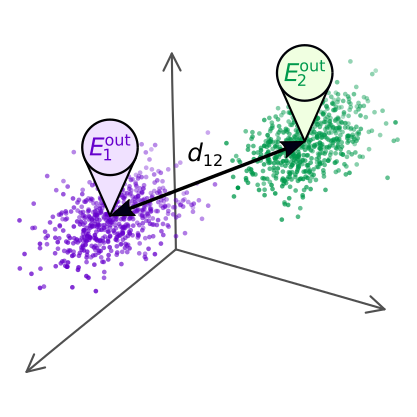 Optimal Control of Coherent Light Scattering for Binary Decision ProblemsDorian Bouchet, Lukas M. Rachbauer, Stefan Rotter, Allard P. Mosk, and Emmanuel BossyPhysical Review Letters 127, 253902 (Dec 2021)
Optimal Control of Coherent Light Scattering for Binary Decision ProblemsDorian Bouchet, Lukas M. Rachbauer, Stefan Rotter, Allard P. Mosk, and Emmanuel BossyPhysical Review Letters 127, 253902 (Dec 2021)Because of quantum noise fluctuations, the rate of error achievable in decision problems involving several possible configurations of a scattering system is subject to a fundamental limit known as the Helstrom bound. Here, we present a general framework to calculate and minimize this bound using coherent probe fields with tailored spatial distributions. As an example, we experimentally study a target located in between two disordered scattering media. We first show that the optimal field distribution can be directly identified using a general approach based on scattering matrix measurements. We then demonstrate that this optimal light field successfully probes the presence of the target with a number of photons that is reduced by more than 2 orders of magnitude as compared to unoptimized fields.
-
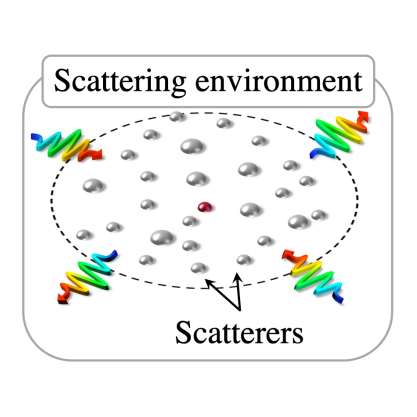 Invariance Property of the Fisher Information in Scattering MediaMichael Horodynski, Dorian Bouchet, Matthias Kühmayer, and Stefan RotterPhysical Review Letters 127, 233201 (Dec 2021)
Invariance Property of the Fisher Information in Scattering MediaMichael Horodynski, Dorian Bouchet, Matthias Kühmayer, and Stefan RotterPhysical Review Letters 127, 233201 (Dec 2021)Determining the ultimate precision limit for measurements on a subwavelength particle with coherent laser light is a goal with applications in areas as diverse as biophysics and nanotechnology. Here, we demonstrate that surrounding such a particle with a complex scattering environment does, on average, not have any influence on the mean quantum Fisher information associated with measurements on the particle. As a remarkable consequence, the average precision that can be achieved when estimating the particle’s properties is the same in the ballistic and in the diffusive scattering regime, independently of the particle’s position within its nonabsorbing environment. This invariance law breaks down only in the regime of Anderson localization, due to increased C0-speckle correlations. Finally, we show how these results connect to the mean quantum Fisher information achievable with spatially optimized input fields.
-
 Maximum information states for coherent scattering measurementsDorian Bouchet, Stefan Rotter, and Allard P. MoskNature Physics 17, 564–568 (May 2021)
Maximum information states for coherent scattering measurementsDorian Bouchet, Stefan Rotter, and Allard P. MoskNature Physics 17, 564–568 (May 2021)The use of coherent light for precision measurements has been a key driving force for numerous research directions, ranging from biomedical optics1,2 to semiconductor manufacturing3. Recent work demonstrates that the precision of such measurements can be substantially improved by tailoring the spatial profile of light fields used for estimating an observable system parameter4–10. These advances naturally raise the intriguing question of which states of light can provide the ultimate measurement precision11. Here we introduce a general approach to determine the optimal coherent states of light for estimating any given parameter, regardless of the complexity of the system. Our analysis reveals that the light fields delivering the ultimate measurement precision are eigenstates of a Hermitian operator that quantifies the Fisher information from the system’s scattering matrix12. To illustrate this concept, we experimentally show that these maximum information states can probe the phase or the position of an object that is hidden by a disordered medium with a precision improved by an order of magnitude compared with unoptimized states. Our results enable optimally precise measurements in arbitrarily complex systems, thus establishing a new benchmark for metrology and imaging applications3,13.
-
 Fundamental Bounds on the Precision of Classical Phase MicroscopesDorian Bouchet, Jonathan Dong, Dante Maestre, and Thomas JuffmannPhysical Review Applied 15, 024047 (Feb 2021)
Fundamental Bounds on the Precision of Classical Phase MicroscopesDorian Bouchet, Jonathan Dong, Dante Maestre, and Thomas JuffmannPhysical Review Applied 15, 024047 (Feb 2021)A wide variety of imaging systems have been designed to measure phase variations, with applications from physics to biology and medicine. In this work, we theoretically compare the precision of phase estimations achievable with classical phase microscopy techniques, operated at the shot-noise limit. We show how the Cramér-Rao bound is calculated for any linear optical system, including phase-contrast microscopy, phase-shifting holography, spatial light interference microscopy, and local optimization of wavefronts for phase imaging. Through these examples, we demonstrate how this general framework can be applied for the design and optimization of classical phase microscopes. Our results show that wavefront shaping is required to design phase microscopes with optimal phase precision.
-
 Efficient and flexible approach to ptychography using an optimization framework based on automatic differentiationJacob Seifert, Dorian Bouchet, Lars Loetgering, and Allard P. MoskOSA Continuum 4, 121–128 (Jan 2021)
Efficient and flexible approach to ptychography using an optimization framework based on automatic differentiationJacob Seifert, Dorian Bouchet, Lars Loetgering, and Allard P. MoskOSA Continuum 4, 121–128 (Jan 2021)Ptychography is a lensless imaging method that allows for wavefront sensing and phase-sensitive microscopy from a set of diffraction patterns. Recently, it has been shown that the optimization task in ptychography can be achieved via automatic differentiation (AD). Here, we propose an open-access AD-based framework implemented with TensorFlow, a popular machine learning library. Using simulations, we show that our AD-based framework performs comparably to a state-of-the-art implementation of the momentum-accelerated ptychographic iterative engine (mPIE) in terms of reconstruction speed and quality. AD-based approaches provide great flexibility, as we demonstrate by setting the reconstruction distance as a trainable parameter. Lastly, we experimentally demonstrate that our framework faithfully reconstructs a biological specimen.
-
 Optimizing illumination for precise multi-parameter estimations in coherent diffractive imagingDorian Bouchet, Jacob Seifert, and Allard P. MoskOptics Letters 46, 254–257 (Jan 2021)
Optimizing illumination for precise multi-parameter estimations in coherent diffractive imagingDorian Bouchet, Jacob Seifert, and Allard P. MoskOptics Letters 46, 254–257 (Jan 2021)Coherent diffractive imaging (CDI) is widely used to characterize structured samples from measurements of diffracting intensity patterns. We introduce a numerical framework to quantify the precision that can be achieved when estimating any given set of parameters characterizing the sample from measured data. The approach, based on the calculation of the Fisher information matrix, provides a clear benchmark to assess the performance of CDI methods. Moreover, by optimizing the Fisher information metric using deep learning optimization libraries, we demonstrate how to identify the optimal illumination scheme that minimizes the estimation error under specified experimental constraints. This work paves the way for an efficient characterization of structured samples at the sub-wavelength scale.
2020
-
 Influence of the Local Scattering Environment on the Localization Precision of Single ParticlesDorian Bouchet, Rémi Carminati, and Allard P. MoskPhysical Review Letters 124, 133903 (Apr 2020)
Influence of the Local Scattering Environment on the Localization Precision of Single ParticlesDorian Bouchet, Rémi Carminati, and Allard P. MoskPhysical Review Letters 124, 133903 (Apr 2020)We study the fundamental limit on the localization precision for a subwavelength scatterer embedded in a strongly scattering environment, using the external degrees of freedom provided by wavefront shaping. For a weakly scattering target, the localization precision improves with the value of the local density of states at the target position. For a strongly scattering target, the localization precision depends on the dressed polarizability that includes the backaction of the environment. This numerical study provides new insights for the control of the information content of scattered light by wavefront shaping, with potential applications in sensing, imaging, and nanoscale engineering.
2019
-
 Cramér-Rao analysis of lifetime estimations in time-resolved fluorescence microscopyDorian Bouchet, Valentina Krachmalnicoff, and Ignacio IzeddinOptics Express 27, 21239–21252 (Jul 2019)
Cramér-Rao analysis of lifetime estimations in time-resolved fluorescence microscopyDorian Bouchet, Valentina Krachmalnicoff, and Ignacio IzeddinOptics Express 27, 21239–21252 (Jul 2019)Measuring the lifetime of fluorescent emitters by time-correlated single photon counting (TCSPC) is a routine procedure in many research areas spanning from nanophotonics to biology. The precision of such measurement depends on the number of detected photons but also on the various sources of noise arising from the measurement process. Using Fisher information theory, we calculate the lower bound on the precision of lifetime estimations for mono-exponential and bi-exponential distributions. We analyse the dependence of the lifetime estimation precision on experimentally relevant parameters, including the contribution of a non-uniform background noise and the instrument response function (IRF) of the setup. We also provide an open-source code to determine the lower bound on the estimation precision for any experimental conditions. Two practical examples illustrate how this tool can be used to reach optimal precision in time-resolved fluorescence microscopy.
-
 Quantum dipole emitters in structured environments: a scattering approach: tutorialDorian Bouchet, and Rémi CarminatiJournal of the Optical Society of America A 36, 186–195 (Feb 2019)
Quantum dipole emitters in structured environments: a scattering approach: tutorialDorian Bouchet, and Rémi CarminatiJournal of the Optical Society of America A 36, 186–195 (Feb 2019)We provide a simple semi-classical formalism to describe the coupling between one or several quantum emitters and a structured environment. Describing the emitter by an electric polarizability, and the surrounding medium by a Green function, we show that an intuitive scattering picture allows one to derive a coupling equation from which the eigenfrequencies of the coupled system can be extracted. The model covers a variety of regimes observed in light–matter interaction, including weak and strong coupling, coherent collective interactions, and incoherent energy transfer. It provides a unified description of many processes, showing that different interaction regimes are actually rooted on the same ground. It can also serve as a basis for the development of more refined models in a full quantum electrodynamics framework.
-
 Probing near-field light-matter interactions with single-molecule lifetime imagingD. Bouchet, J. Scholler, G. Blanquer, Y. De Wilde, I. Izeddin, and V. KrachmalnicoffOptica 6, 135–138 (Feb 2019)
Probing near-field light-matter interactions with single-molecule lifetime imagingD. Bouchet, J. Scholler, G. Blanquer, Y. De Wilde, I. Izeddin, and V. KrachmalnicoffOptica 6, 135–138 (Feb 2019)Nanophotonics offers a promising range of applications spanning from the development of efficient solar cells to quantum communications and biosensing. However, the ability to efficiently couple fluorescent emitters with nanostructured materials requires one to probe light–matter interactions at a subwavelength resolution, which remains experimentally challenging. Here, we introduce an approach to perform super-resolved fluorescence lifetime measurements on samples that are densely labeled with photo-activatable fluorescent molecules. The simultaneous measurement of the position and the decay rate of the molecules provides direct access to the local density of states (LDOS) at the nanoscale. We experimentally demonstrate the performance of the technique by studying the LDOS variations induced in the near field of a silver nanowire, and we show via a Cramér–Rao analysis that the proposed experimental setup enables a single-molecule localization precision of 6 nm.
2017
-
 Correlated blinking of fluorescent emitters mediated by single plasmonsD. Bouchet, E. Lhuillier, S. Ithurria, A. Gulinatti, I. Rech, R. Carminati, Y. De Wilde, and V. KrachmalnicoffPhysical Review A 95, 033828 (Mar 2017)
Correlated blinking of fluorescent emitters mediated by single plasmonsD. Bouchet, E. Lhuillier, S. Ithurria, A. Gulinatti, I. Rech, R. Carminati, Y. De Wilde, and V. KrachmalnicoffPhysical Review A 95, 033828 (Mar 2017)We observe time-correlated emission between a single CdSe/CdS/ZnS quantum dot exhibiting single-photon statistics and a fluorescent nanobead located micrometers apart. This is accomplished by coupling both emitters to a silver nanowire. Single plasmons are created on the latter from the quantum dot, and transfer energy to excite in turn the fluorescent nanobead. We demonstrate that the molecules inside the bead show the same blinking behavior as the quantum dot.
2016
-
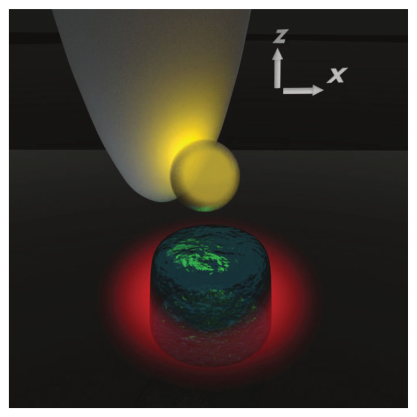 Enhancement and Inhibition of Spontaneous Photon Emission by Resonant Silicon NanoantennasDorian Bouchet, Mathieu Mivelle, Julien Proust, Bruno Gallas, Igor Ozerov, Maria F. Garcia-Parajo, Angelo Gulinatti, Ivan Rech, and 4 more authorsPhysical Review Applied 6, 064016 (Dec 2016)
Enhancement and Inhibition of Spontaneous Photon Emission by Resonant Silicon NanoantennasDorian Bouchet, Mathieu Mivelle, Julien Proust, Bruno Gallas, Igor Ozerov, Maria F. Garcia-Parajo, Angelo Gulinatti, Ivan Rech, and 4 more authorsPhysical Review Applied 6, 064016 (Dec 2016)Substituting noble metals for high-index dielectrics has recently been proposed as an alternative strategy in nanophotonics to design broadband optical resonators and circumvent the Ohmic losses of plasmonic materials. In this paper, we demonstrate that subwavelength silicon nanoantennas can manipulate the photon emission dynamics of fluorescent molecules. In practice, we show that dielectric nanoantennas can both increase and decrease the local density of optical states at room temperature, a process that is inaccessible with noble metals at the nanoscale. Using scanning probe microscopy, we analyze quantitatively, in three dimensions, the near-field interaction between a 100-nm fluorescent nanosphere and silicon nanoantennas with diameters ranging between 170 and 250 nm. Associated with numerical simulations, these measurements indicate increased or decreased total spontaneous decay rates by up to 15% and a gain in the collection efficiency of emitted photons by up to 85%. Our study demonstrates the potential of silicon-based nanoantennas for the low-loss manipulation of solid-state emitters at the nanoscale and at room temperature.
-
 Long-Range Plasmon-Assisted Energy Transfer between Fluorescent EmittersD. Bouchet, D. Cao, R. Carminati, Y. De Wilde, and V. KrachmalnicoffPhysical Review Letters 116, 037401 (Jan 2016)
Long-Range Plasmon-Assisted Energy Transfer between Fluorescent EmittersD. Bouchet, D. Cao, R. Carminati, Y. De Wilde, and V. KrachmalnicoffPhysical Review Letters 116, 037401 (Jan 2016)We demonstrate plasmon-assisted energy transfer between fluorophores located at distances up to 7 μm on the top of a thin silver film. Thanks to the strong confinement and large propagation length of surface plasmon polaritons, the range of the energy transfer is almost 2 orders of magnitude larger than the values reported in the literature so far. The parameters driving the energy transfer range are thoroughly characterized and are in very good agreement with theoretically expected values.
